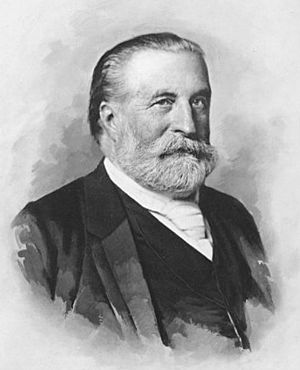Ernst von Bergmann facts for kids
Quick facts for kids
Ernst von Bergmann
|
|
|---|---|

von Bergmann c. 1890
|
|
| Born |
Ernst Gustav Benjamin von Bergmann
16 December 1836 Riga, Livonia Governorate, Russian Empire
|
| Died | 25 March 1907 (aged 70) Wiesbaden, Kingdom of Prussia, German Empire
|
| Nationality | Baltic German |
| Alma mater | University of Dorpat |
| Known for | Sterilisation of surgical instruments and Hydrocolectomy |
| Scientific career | |
| Fields | Surgeon |
| Institutions | University of Berlin |
Ernst von Bergmann (born December 16, 1836, died March 25, 1907) was a famous Baltic German doctor who specialized in surgery. He was a very important person in medicine because he was the first to use heat sterilization for surgical instruments. This means he used heat to kill germs on tools used in operations. He is also known for being a leader in aseptic surgery, which means performing surgery in a way that prevents germs from causing infections.
Contents
Ernst von Bergmann's Life Story
Ernst von Bergmann was born in Riga, which is now part of Latvia. He studied medicine and earned his doctorate degree in 1860 from the University of Dorpat. After that, he worked as an assistant at a surgery clinic. He learned a lot about surgery from his teachers, including Georg von Adelmann.
In 1864, he became a certified surgeon. He then taught surgery as a professor at Dorpat from 1871 to 1878. Later, he moved to the University of Würzburg in 1878. In 1882, he became a professor of surgery at the famous University of Berlin. He stayed in Berlin for the rest of his career. His son, Gustav von Bergmann, also became a well-known doctor.
How Bergmann Changed Surgery
Ernst von Bergmann made huge improvements in how surgeries were done. He was the first doctor to use heat sterilization for all surgical instruments. This simple but powerful idea helped to greatly reduce the number of infections patients got after operations. Before this, many people died from infections.
He also showed that using steam-sterilized bandages was much better than using chemicals to clean wounds. He was also one of the first doctors to wear a "white coat" during surgery. This helped keep things clean and showed a professional look.
Helping Soldiers in War
Bergmann also served as a medical officer in several wars. These included the Austro-Prussian War (1866), the Franco-Prussian War (1870–71), and the Russo-Turkish War (1877–78). During these wars, he gained a lot of experience treating serious wounds. He was very interested in how diseases started and spread, especially with battle wounds. He realized how important it was to have well-trained nurses and medical staff. He also developed better ways to treat gunshot wounds, especially those affecting joints and the head.
New Surgical Procedures
Bergmann was a pioneer in many surgical procedures. He developed a new way to perform hydrocelectomy, which is an operation to fix a condition called hydrocele. He also helped improve appendectomy procedures, which is surgery to remove the appendix. He even performed the first successful operation on an esophageal diverticulum, which is a pouch that can form in the esophagus.
His Writings and Legacy
Ernst von Bergmann wrote many important medical books. One of his most famous books was about head injuries, called Die Lehre von den Kopfverletzungen (1880). He also wrote a book about brain surgery in 1888. In 1904, he helped start a medical journal called Zeitschrift für ärztliche Fortbildung (Journal of Medical Education).
He passed away in Wiesbaden in 1907. Today, several places are named in his honor, like the Ernst von Bergmann Clinic in Potsdam and the Ernst-von-Bergmann-Kaserne in Munich. The German Medical Association also has an award named after him.
Images for kids
See also
- List of Baltic German scientists




